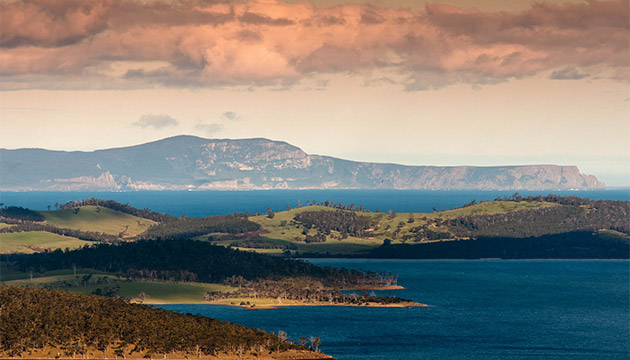Take the slow and scenic route from Hobart to Cockle Creek and you’ll experience pretty islands, rolling farmlands and stunning forests.
Story By Don Fuchs
The drive from Hobart south to Cockle Creek and back can be done in a day. What lies between the two locations, however, warrants a much slower approach. Ignoring the Huon Highway (the fast commuter connection to Kingston only 13 kilometres south of Hobart), the coastal route through Sandy Bay weans travellers from the city and eases them into one of the most picturesque corners of Tasmania. Wooded hills, panoramic views and lush green paddocks form a cosy, small-scale landscape bordered by the D’Entrecasteaux Channel. Only a stone’s throw from the notoriously wild Southern Ocean, the channel is broken up by islands and peninsulas, forming a sheltered world of great beauty.
One of the landforms that borders the D’Entrecasteaux Channel and dominates views is Bruny Island, the first major distraction on the way south. The car ferry from Kettering docks at Roberts Point on North Bruny Island. Not far from the ferry terminal, after a few kilometres of rolling hills and sheep paddocks, lays Great Bay. It is here that Joe Bennett purchased a run-down oyster farm in 2004 and turned it into a booming business.
“We operate a sub-tidal forced farm, which means the oysters are 24/7 under water,” the lanky blond 31 year old says while hauling baskets full of mature oysters onto his boat with a small crane. “It’s a low-risk area in terms of oyster farming. The water is unpolluted and clean, the temperature is right.” He sells 120,000 dozen per year and runs a farm shop nearby where locals and tourists can purchase the seafood freshly shucked.
Joe is an island man through and through. He grew up on South Bruny Island and loves that the population is small. “In wintertime you rarely see a car on the road,” he says. For him Bruny Island means, “Surfing, fishing, diving, open space and having the sea all around you. I find it difficult when I’m on holiday to go somewhere where I’m not close to the water”. But it is also the spread-out community, with its changing demographics, that works for him. “My partner and I enjoy living here because of the people that are down here now,” he says. “There are some fantastic businesses and young people here.”
This story excerpt is from Issue #88
Outback Magazine: Apr/May 2013










